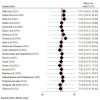Prevalence of work-related musculoskeletal disorder and its associated factors among weavers in low- and middle-income countries: a systematic review and meta-analysis
- PMID: 40754326
- PMCID: PMC12320042
- DOI: 10.1136/bmjopen-2024-093124
Prevalence of work-related musculoskeletal disorder and its associated factors among weavers in low- and middle-income countries: a systematic review and meta-analysis
Abstract
Objective: This systematic review and meta-analysis aimed to determine the pooled prevalence of and factors associated with work-related musculoskeletal disorders (WMSDs) among low- and middle-income countries.
Methods and design: Databases such as PubMed/MEDLINE, CINAHL, LIVIVO, African Journals Online, African Index Medicus (AIM), HINARI, Science Direct, Web of Science, Cochrane Library, Google Scholar, Semantic Scholar and Google were used to retrieve all the relevant articles. The search was carried out from 22 April 2024 to 26 June 2024. Data were analysed via STATA 17 software. With a 95% CI, this meta-analysis with a random-effects model was carried out to determine the pooled prevalence.
Setting: The study was conducted in low- and middle-income countries.
Participants: Weavers of low- and middle-income countries.
Outcome measures: The primary outcome of this study was the prevalence of WMSD.
Result: In this meta-analysis, a total of 21 articles with 7322 study participants were included. The pooled prevalence of WMSDs was 72.20%. Working more than 8 hours per day, working in a chair with no back support, working in an uncomfortable posture, not performing regular physical exercise, lacking knowledge of the causes of WMSD and lacking job satisfaction were factors significantly associated with WMSDs.
Conclusion: A high prevalence of WMSDs among weavers in low- and middle-income countries was recorded. This indicates the need to take effective intervention measures. Rigorous ergonomic training, providing lengthy breaks and building centres for physical exercise, improving workplace ergonomic design and increasing job satisfaction are recommended.
Prospero registration number: CRD42024561064.
Keywords: Musculoskeletal disorders; Occupational Health Services; Occupational Stress; Work Satisfaction.
© Author(s) (or their employer(s)) 2025. Re-use permitted under CC BY-NC. No commercial re-use. See rights and permissions. Published by BMJ Group.
Conflict of interest statement
Competing interests: None declared.
Figures





Similar articles
-
Prevalence of low back pain and its associated factors among weavers in low- and middle- income countries: a systematic review and meta-analysis.BMC Musculoskelet Disord. 2025 Aug 2;26(1):744. doi: 10.1186/s12891-025-08967-4. BMC Musculoskelet Disord. 2025. PMID: 40753385 Free PMC article.
-
Work-related musculoskeletal disorders and associated factors among hospital sanitary workers in public hospitals of Eastern Ethiopia.BMC Musculoskelet Disord. 2025 Jul 4;26(1):640. doi: 10.1186/s12891-025-08873-9. BMC Musculoskelet Disord. 2025. PMID: 40616057 Free PMC article.
-
The prevalence and risk factors of work-related musculoskeletal disorders among nurses in China: A systematic review and meta-analysis.Int J Nurs Stud. 2024 Sep;157:104826. doi: 10.1016/j.ijnurstu.2024.104826. Epub 2024 May 25. Int J Nurs Stud. 2024. PMID: 38843644
-
Musculoskeletal disorders among computer user workers in Ethiopia: a systematic review and meta-analysis.Sci Rep. 2025 Jul 24;15(1):26858. doi: 10.1038/s41598-025-96470-0. Sci Rep. 2025. PMID: 40702114 Free PMC article.
-
Knowledge and practice of essential newborn care and associated factors among women in Ethiopia: systematic review and meta-analysis.Reprod Health. 2022 Aug 4;19(1):172. doi: 10.1186/s12978-022-01480-0. Reprod Health. 2022. PMID: 35927762 Free PMC article.
References
-
- Luttmann A, Jager M, Griefahn B, et al. Preventing musculoskeletal disorders in the workplace. 2003.
Publication types
MeSH terms
LinkOut - more resources
Full Text Sources
Medical
Miscellaneous
